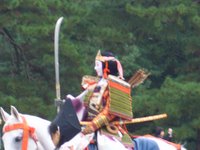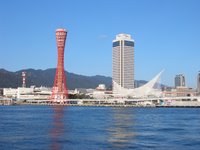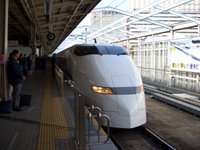Oct. 22 - Jidai Matsuri, Kyomizu Temple, and Gion in Kyoto:
I had secured a good 13 days off through regular paid holidays and four shiftswaps which required I work straight through a weekend. And despite forec

asts of scattered showers I was in a genial mood as we left that morning. Thomas had slept off the jetlag quite well, and we made our way to Hankyu Nishinomiya Kitaguchi station, where we bought a Kyoto day pass. If you're ever in the Kansai area and want to spend a day of sightseeing in one of the main cities, getting a day pass from the ticket center of any major Hankyu station is a good way to do it. The Kyoto pass includes travel on the Hankyu rail anywhere it goes in the Kansai area throughout Osaka and Kobe and Kyoto including travel on the Kyoto buses and subway lines. In addition you get a bunch of coupons for discounts to sightseeing hotspots, such as temples and museums.
We got our tickets and then took the train to Osaka. You can catch trains to Kawaramachi (the main Kyoto Hankyu station) at Juso station, but it makes more sense to go all the way to Osaka to be assured of getting a seat for the hour long train ride into the heart of Kyoto.
We made our way to the Imperial Palace and took our seats, only to be approached immediately by a bunch of school children speaking formulaic English asking about where we were from and

where we've been to in Japan so far. They gave us origami cranes and what looked like frogs, some students of course, being more adept at folding than their classmates, and then were shooed away by their teacher to the next group of foreigners along the parade route which stretched on either side of the wide walkway leading to the main entrance of the Imperial Palace.
Although a copy of the original, built in 1855-1856, and situated well northeast of its first location, I found it impressive to know that there had been an imperial palace in Kyoto as early as 794AD. And even though the procession commemorates the founding of the city, the actual festival itself wasn't started until 1895 to celebrate Kyoto's 1,100 anniversary. The Heian Jingu Shrine where the festival ends was built in the year of foundation as a commemoration of the removal of the capital from Nara to Kyoto. In the evening there is a second event known as the Kuruma Torch Festival held at Yuki shrine. Jidai Matsuri is one of the big three festivals held in Kyoto. The other two are Gion Matsuri held on July 17th and Aoi Matsuri which you can see on May 15th.
Another good one to see, should you ever get the chance is the Nada Fighting Festival held in Himeji on October 14th and 15th. It's a visual spectacle where different brightly colored fronds are stuck onto the end of thick bamboo poles and palanquins (portable shrines weighing over two tons) are slammed together in a ritual fight. Yes, sometimes people are trampled and killed, but it is believed that the harder the knocks, the more appeased will be the spirits who enjoy watching the event. I went to the Nada festival last year, before I had bought a digital camera, so I'll have to scan my photos later on.
As for the festival we saw on October 22nd, though much more subdued than it's counterpart that took place a week earlier in Himeji, it's a really good way of visualizing Japanese history as representatives from Heian period to the Meiji Restoration are featured in the procession. I found it notable that there was so much interest in featuring important women of the various ages in the festival. For example, Lady Shizuka, featured right, was a dancer in Kyoto and the favored concubine of Minamoto Yoshitsune.

Yoshitsune was a talented general and half-brother of Yoritomo, who eventually gained control of Japan towards the end of the Heian period. Yoshitsune was so skilled and liked that he gained the favor of the emperor and his court, much to the dismay of Yoritomo who eventually forced his suicide and had his head brought to him in a jar of sake. This and other exploits of Lady Shizuka and Yoshitsune, as well as his retainer, Benkei feature not only in Kabuki and Noh, but in a few western novels as well. Sorry, I haven't read any of them, so I can't give you any recommendations.
In fact, I haven't even read the
Tale of Genji, perhaps the most seminal work in Japanese literature. Here too, we have an example of an important woman in Japanese history,
Genji's author, Murasaki-Shikibu (featured in contemporary clothes at front, below).

But perhaps the most striking image of an importatant historical woman in Japan I saw at the festival was of Tomoe Gozen, the wife of general Kiso Yoshinaka.
Perhaps the Japanese equivalent of Joan of Arc, she was skilled as any man with sword and spear, fighting bravely along with her lover. I think her image captured my imagination the most out of the entire procession. I won't go into too much detail, as this post is already running pretty long, but click
here to learn more about this stunning figure.

After the festival had wound it's way out of sight we headed for lunch back in Kawaramachi before hopping the bus out towards Gion and Kiyomizu temple. Perhaps the most popular temple in the area, Kiyomizu's origins date to 798 but what you can see dates back to about 1633. "Kiyomizu" actually means "clear water," which might explain the tendency for visitors to drink from the nearby Otawa waterfall using long-handled tin cups.

It is said that the water from this spring has magic curative properties. I suppose it can't hurt to take a sip. The Gion area is a must see if you ever come to Kyoto. The old-fashioned houses and narrow coble-stone streets leading up to the temple are well worth the sore legs you're likely to feel afterwards. That part of Kyoto, is filled with interesting sites, including Ryozen Kannon Temple, Kodaiji, the Yasaka pagoda, and Maruyama Koen park. If you head north from Kiyomizu temple you can continue on up into the park to get a look at Chion-in Temple and Shoren-in Temple or make the earlier left into the Yasaka shrine, and re-enter the modern world as you walk down the steps to Shijo-dori street.
Labels: travel











